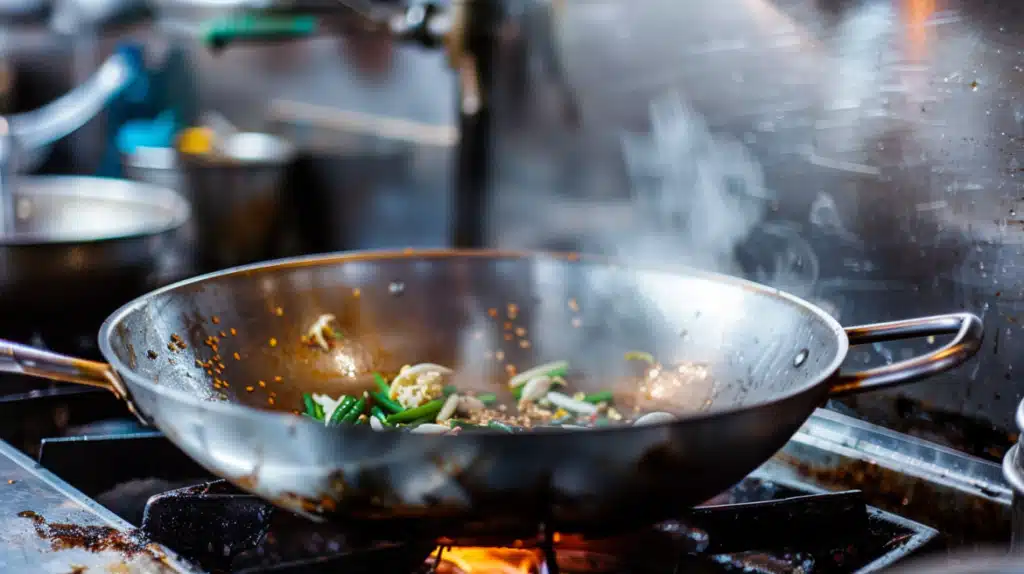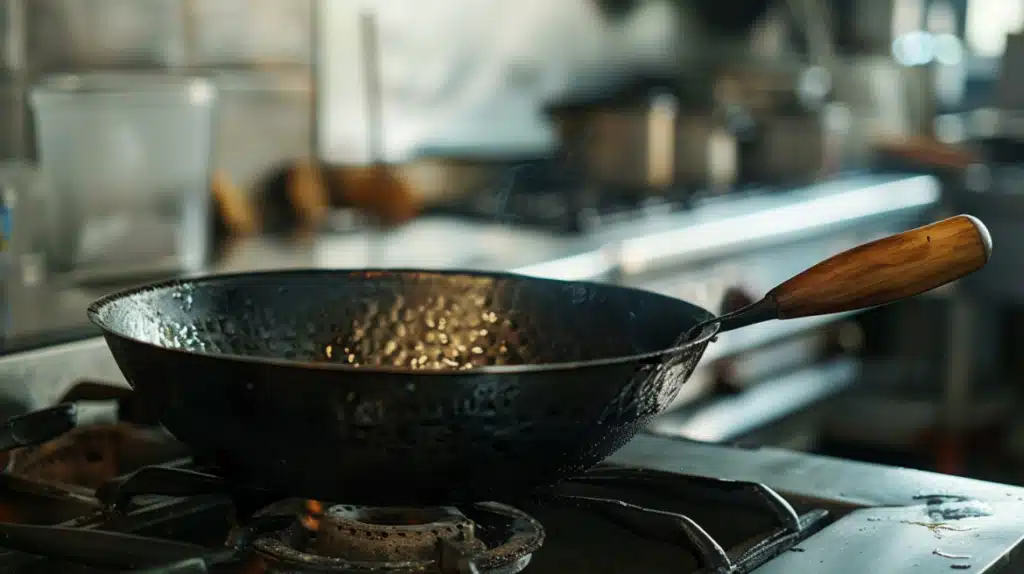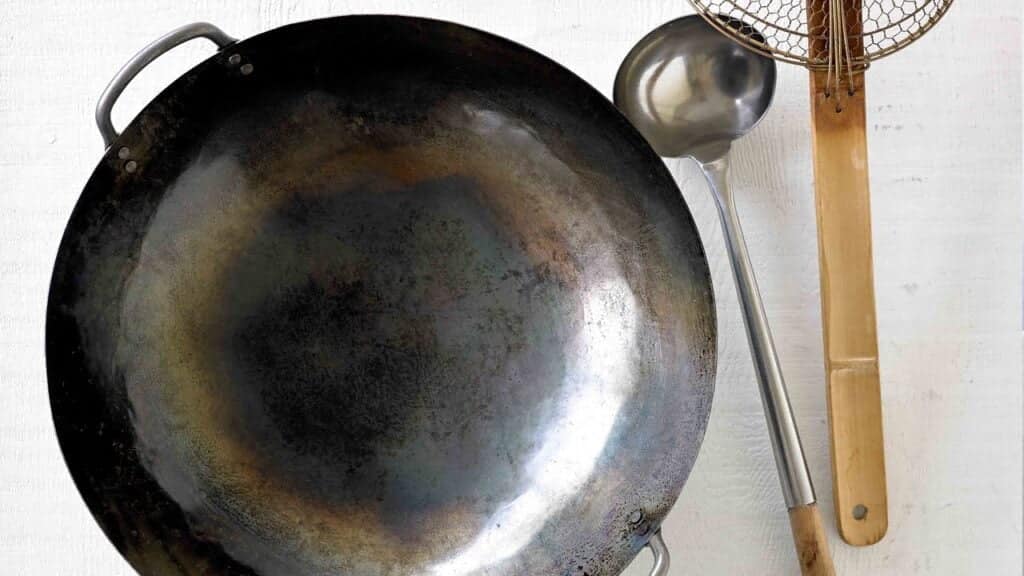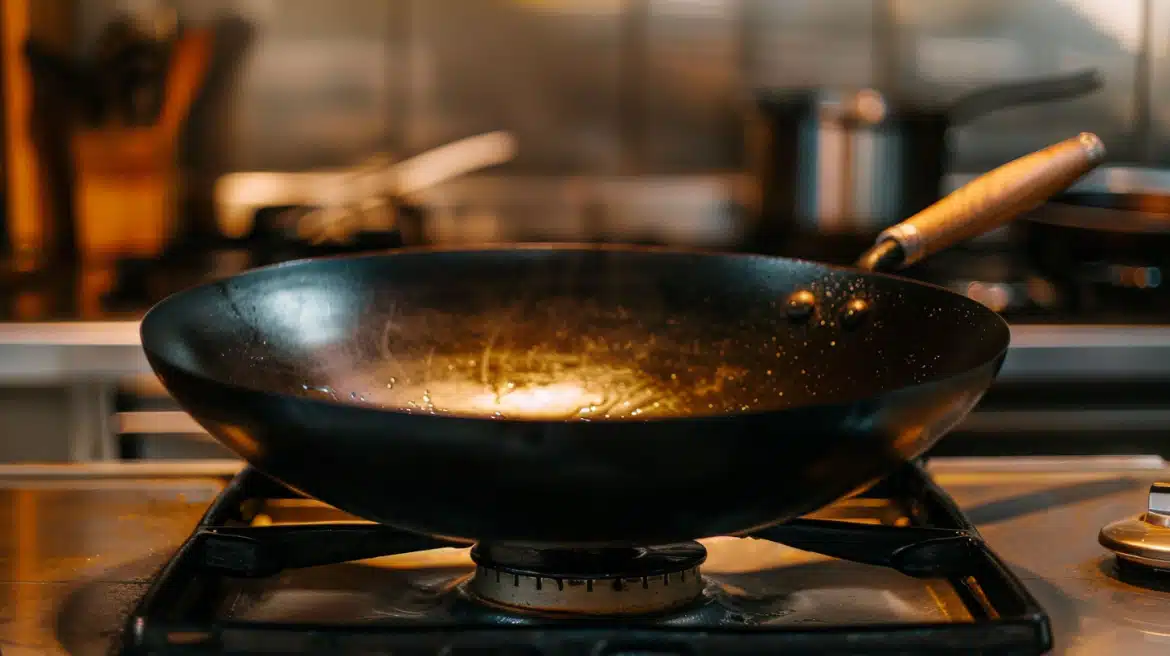Seasoning a Wok is crucial for creating a naturally non-stick surface that enhances your cooking experience.
However, many home cooks need help with common mistakes that lead to uneven seasoning, rust, or a sticky work surface.
This guide walks you through the essential steps to avoid these pitfalls and achieve perfectly seasoned wok that will last for years.
This guide will cover the importance of choosing the right Wok, removing the manufacturer’s coating, applying oil correctly, and maintaining your Wok’s seasoning through proper use and care. Each step is crucial in achieving a perfectly seasoned Wok.
By following these simple yet effective tips, you can confidently season your Wok and enjoy delicious, restaurant-quality stir-fries and other dishes in the comfort of your kitchen.
Essential Benefits of Proper Wok Seasoning
| Benefits of Proper Wok Seasoning | Description |
|---|---|
| Non-Stick Surface | Oils polymerize during seasoning, forming a nonstick, plastic-like layer on the Wok’s surface. This makes cooking and cleaning easier and requires less oil. |
| Rust Prevention | The oil layer created during seasoning is a barrier against moisture, the main cause of rust, extending the Wok’s lifespan. |
| Enhanced Flavor | A well-seasoned Wok imparts a unique, smoky flavor to dishes, known as “Wok hei,” elevating the taste of stir-fries and other cuisines. |
| Even Heat Distribution | Proper seasoning improves the Wok’s ability to distribute heat evenly, ensuring that meals are cooked uniformly and efficiently. |
Seasoning is the foundation of a Wok’s cooking performance and longevity.
It creates a protective layer that prevents rust, provides a non-stick surface, and enhances the flavor of the dishes.
1. Non-stick Surface
The seasoning process involves a chemical reaction called polymerization, where fats are broken down and reformed into a plastic-like coating on the Wok’s surface.
This non-stick layer offers several advantages, such as easier cooking and cleaning, reduced need for oil, and better heat distribution, ensuring evenly cooked meals.
2. Rust Prevention
- The oil layer formed during seasoning is a barrier against oxidation and moisture, the main culprit behind rust formation.
- Proper cleaning techniques and occasional re-seasoning are essential to maintaining this protective layer.
- Always dry your Wok thoroughly after washing it, and apply a thin coat of oil before storing it to prevent rust.
3. Flavor Enhancement
A well-seasoned Wok imparts a unique, smoky flavor to its dishes, known as “Wok hei.” This complex flavor profile is highly prized in Chinese cuisine and can elevate stir-fries.
To achieve this characteristic flavor, ensure your work is properly seasoned and maintained, and use high heat while cooking to allow the flavors to develop.
Common Seasoning Mistakes and Troubleshooting
| Common Seasoning Mistakes | Fixes |
|---|---|
| Not Removing Manufacturing Residue | Use hot, soapy water and a non-abrasive scrub pad to thoroughly clean the Wok before seasoning to remove protective coatings. |
| Uneven Application of Oil | Apply a thin, even layer of high smoke point oil using a paper towel or cloth. Heat the Wok slowly over medium heat to allow the oil to spread evenly. |
| Using Low Smoke Point Oils | Avoid oils like olive or butter. Opt for vegetable, canola, or peanut oil, which have higher smoke points and are better suited for seasoning and high-heat cooking. |
| Insufficient Heating During Seasoning | Heat the Wok until it starts to smoke or changes color, indicating that it’s hot enough for the oil to bond well with the metal surface. |
| Failure to Dry Wok Completely | After washing, dry the Wok thoroughly by heating it over the stove on medium heat until all moisture evaporates, preventing rust formation. |
| Cooking Acidic Foods Too Early | Limit acidic ingredients like tomatoes or lemon juice early in the seasoning’s life. If used, re-season the Wok as necessary afterward. |
| Overcrowding During Cooking | Avoid adding too much food at once. Doing so can lower the temperature of the Wok and lead to uneven cooking and seasoning. Cook in smaller batches instead. |
| Improper Storage | After cleaning and oiling, store the Wok in a dry, temperate environment. If storing for long periods, apply a thicker layer of oil to protect against rust. |
Even with the best intentions, mistakes can happen during the seasoning process. Here are some common issues and how to address them.
1. Overcrowding
- Overcrowding your Wok with less food can lead to uneven cooking and damage to the seasoning.
- The sudden addition of a large amount of food can cool the Wok down, preventing it from maintaining the high temperature needed for proper stir-frying and seasoning maintenance.
- To avoid this, cook in smaller batches and allow the Wok to reheat between each batch.
2. Wrong Oil Usage
- Using the wrong type of oil can negatively impact your Wok’s seasoning.
- Oils with low smoke points, such as olive oil or butter, can burn and leave a sticky residue that is difficult to remove.
- Always use high smoke point oils like vegetable, canola, or peanut oil for seasoning and cooking.
3. Acidic Foods and Re-seasoning
- Cooking acidic foods, such as tomatoes, vinegar, or lemon juice, can break down the seasoning on your Wok over time.
- If you notice the seasoning deteriorating after cooking acidic dishes, re-season your Wok following the steps outlined in the seasoning process section.
- To minimize the impact of acidic ingredients, limit their use or add them near the end of the cooking process.
4. Uneven Seasoning
- Uneven seasoning can occur if the oil is not applied evenly or the Wok is not heated consistently during the seasoning process.
- To fix this issue, gently scrub the Wok with kosher salt and oil to remove rough or sticky spots.
- Then, re-season the Wok, apply a thin, even layer of oil, and heat the Wok slowly over medium heat to allow the seasoning to build up gradually and evenly.
Best Practices for Cooking with a Seasoned Wok

To get the most out of your seasoned Wok, follow these best practices while cooking.
1. High-Heat Cooking
- Cooking with high heat is essential for maintaining your Wok’s seasoning and achieving the best results.
- High temperatures help to create the distinctive “Wok hei” flavor and prevent food from sticking.
- When stir-frying, preheat your Wok until it smokes before adding oil and ingredients.
- This ensures the Wok is hot enough to sear and caramelize the food quickly.
2. Avoiding Acidic Ingredients
- As mentioned earlier, acidic ingredients can degrade the seasoning on your Wok over time.
- While it’s okay to use them occasionally, try to limit their use or add them near the end of the cooking process to minimize their impact.
- If you cook with acidic ingredients frequently, you must re-season your Wok more often to maintain its performance.
3. Regular Use
- The more you use your seasoned Wok, the better it will perform.
- Regular cooking helps to reinforce the seasoning and improve the non-stick properties of the Wok.
- Dishes that are particularly beneficial for maintaining a well-seasoned surface include stir-fries with plenty of oil, such as fried rice or noodles, and dishes that involve cooking meat or vegetables at high temperatures.
- The key is to use your Wok consistently and follow proper maintenance techniques to ensure it stays in top condition.
How to Select the Right Wok?

Choosing the right work is crucial to your cooking experience and the quality of the dishes you create.
Consider material, shape, size, and handle design to find the perfect Wok.
1. Material
- Carbon steel is the preferred material for Woks due to its excellent heat responsiveness and ease of seasoning.
- Unlike stainless steel, which does not hold seasoning well, or non-stick coatings that may offer convenience but lack durability, carbon steel allows you to build up a strong, long-lasting patina that enhances your cooking experience.
2. Shape and Size
- Woks come in different shapes, such as round or flat-bottomed, which affect how they interact with various stove types.
- Round-bottomed Woks are ideal for gas stoves, while flat-bottomed Woks are better suited for electric or induction cooktops.
- When selecting the size of your Wok, consider the number of servings you typically cook.
- Choose a large Wok to accommodate your needs while being easy to handle.
3. Handle Design
- Wok handles come in various designs, each with its benefits and drawbacks.
- Loop handles provide stability and are great for stir-frying or tossing dishes.
- On the other hand, long handles offer more control and are better suited for dishes that require scooping or flipping.
- Consider your cooking style and preferences when selecting a handle design for your Wok.
Preparation for Seasoning a Wok

Proper preparation is key to successful Wok seasoning.
Before you begin the seasoning process, cleaning your Wok thoroughly and ensuring it is completely dry is essential.
1. Initial Cleaning
New wok often comes with a protective coating from the manufacturer, which needs to be removed before seasoning.
Use hot, soapy water and a soft sponge or scrub pad to clean your Wok. Avoid using abrasive materials that could scratch the surface.
Scrub the entire surface, including the inside and outside, to remove any dirt, dust, or remnants of the protective coating.
2. Thorough Drying
After cleaning, it’s crucial to dry your Wok completely.
Any remaining moisture can lead to rust formation, damaging your Wok and affecting its performance.
To thoroughly dry your Wok, place it on the stove over medium heat for a few minutes until all water droplets have evaporated. Once dry, your Wok is ready for seasoning.
Step-by-Step Seasoning Process

Step 1: Heating the Wok
- Begin seasoning by heating your Wok over medium-high heat until it smokes or changes color.
- This indicates that the Wok is ready for oiling. Heating the Wok opens up the pores in the metal, allowing the oil to penetrate and create a strong bond with the surface.
Step 2: Applying the Right Type of Oil
| Oil Type | Smoke Point | Recommended | Notes |
|---|---|---|---|
| Vegetable | High | Yes | Ideal for high-heat cooking |
| Canola | High | Yes | Commonly available and affordable |
| Peanut | High | Yes | A popular choice for its flavor |
| Olive | Low | No | Can burn easily, not suitable |
| Butter | Low | No | Not ideal due to low smoke point |
- For seasoning, choose an oil with a high smoke point, such as vegetable, canola, or peanut oil.
- Avoid oils with low smoke points, like olive oil or butter, as they can burn and leave a sticky residue.
- Apply a thin layer of oil to the entire Wok surface, including the inside, outside, and handle.
- Use a paper towel or clean cloth to spread the oil evenly, ensuring all areas are coated.
Step 3: Cooling and Repeating
- After applying the oil, let the Wok cool slightly before repeating the process.
- Building up multiple thin layers of seasoning creates a strong, durable patina that will protect your Wok and improve your cooking experience.
- Repeat the heating, oiling, and cooling process at least 2-3 times for optimal results.
Maintenance: Post-Seasoning of the Wok

Proper maintenance is essential for preserving your Wok’s seasoning and longevity. After each use, follow these steps to keep your Wok in top condition.
Step 1: Cleaning Techniques
- Clean your Wok immediately after cooking while it is still warm.
- Avoid using soap or abrasive sponges, as these can strip away the seasoning.
- Instead, rinse the Wok with hot water and use a soft brush or sponge to remove any food particles.
- You can add some kosher salt and scrub gently for stubborn bits.
- Rinse the Wok thoroughly and dry it completely over low heat on the stove.
Step 2: Re-oiling Techniques
- To maintain the seasoning, re-oil your Wok after each cleaning.
- Using a paper towel or clean cloth, apply a thin layer of oil (the same type used for seasoning) to the entire surface.
- Heat the Wok over medium heat for a few minutes to allow the oil to bond with the surface. Remove from heat, let it cool, and wipe away any excess oil with a clean cloth.
Step 3: Storage Recommendations
- Store your Wok in a dry place, away from humidity and extreme temperatures, which can degrade the seasoning.
- If you plan on storing your Wok for an extended period, apply a slightly thicker layer of oil to prevent rust.
- When you’re ready to use the Wok again, wash off the excess oil with hot water and dry thoroughly before cooking.
Conclusion
Seasoning your Wok correctly and avoiding common mistakes is essential for creating a durable, non-stick surface to enhance your cooking experience and help you make delicious, authentic Asian dishes.
By selecting the right Wok, preparing it properly, and following the step-by-step seasoning process, you’ll develop a beautiful patina that will make cooking a breeze.
Remember to maintain your Wok after each use by cleaning it gently, re-oiling it when needed, and storing it in a dry place.
If you encounter any issues, refer to the troubleshooting section for guidance on correcting common seasoning mistakes.
Finally, by adopting best practices such as cooking with high heat, avoiding acidic ingredients, and using your Wok regularly, you’ll maximize its performance and enjoy all the benefits of a well-seasoned Wok for years.
With a little care and attention, your trusty Wok will become an indispensable tool in your kitchen, helping you create quick, healthy, and flavorful meals that impress your family and friends.




